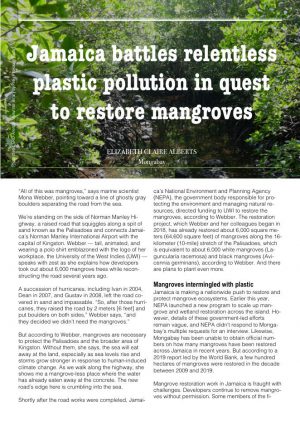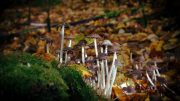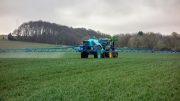 “All of this was mangroves,” says marine scientist Mona Webber, pointing toward a line of ghostly gray boulders separating the road from the sea.
“All of this was mangroves,” says marine scientist Mona Webber, pointing toward a line of ghostly gray boulders separating the road from the sea.
We’re standing on the side of Norman Manley Highway, a raised road that squiggles along a spit of sand known as the Palisadoes and connects Jamaica’s Norman Manley International Airport with the capital of Kingston. Webber — tall, animated, and wearing a polo shirt emblazoned with the logo of her workplace, the University of the West Indies (UWI) — speaks with zest as she explains how developers took out about 6,000 mangrove trees while reconstructing the road several years ago.
A succession of hurricanes, including Ivan in 2004, Dean in 2007, and Gustav in 2008, left the road covered in sand and impassable. “So, after those hurricanes, they raised the road by 2 meters [6 feet] and put boulders on both sides,” Webber says, “and they decided we didn’t need the mangroves.”
But according to Webber, mangroves are necessary to protect the Palisadoes and the broader area of Kingston. Without them, she says, the sea will eat away at the land, especially as sea levels rise and storms grow stronger in response to human-induced climate change. As we walk along the highway, she shows me a mangrove-less place where the water has already eaten away at the concrete. The new road’s edge here is crumbling into the sea.
Shortly after the road works were completed, Jamaica’s National Environment and Planning Agency (NEPA), the government body responsible for protecting the environment and managing natural resources, directed funding to UWI to restore the mangroves, according to Webber. The restoration project, which Webber and her colleagues began in 2018, has already restored about 6,000 square meters (64,600 square feet) of mangroves along the 16-kilometer (10-mile) stretch of the Palisadoes, which is equivalent to about 6,000 white mangroves (Laguncularia racemosa) and black mangroves (Avicennia germinans), according to Webber. And there are plans to plant even more.
Mangroves intermingled with plastic
Jamaica is making a nationwide push to restore and protect mangrove ecosystems. Earlier this year, NEPA launched a new program to scale up mangrove and wetland restoration across the island. However, details of these government-led efforts remain vague, and NEPA didn’t respond to Mongabay’s multiple requests for an interview. Likewise, Mongabay has been unable to obtain official numbers on how many mangroves have been restored across Jamaica in recent years. But according to a 2019 report led by the World Bank, a few hundred hectares of mangroves were restored in the decade between 2009 and 2019.
Mangrove restoration work in Jamaica is fraught with challenges. Developers continue to remove mangroves without permission. Some members of the fishing community chop mangrove roots to harvest the cupped oysters (Crassostrea rhizophorae) that live on the plants rather than picking the oysters off. People also cut down mangroves to use the wood for charcoal. Mangrove proponents struggle to educate the wider community about the benefits of mangroves and to prevent their illegal destruction.
For the mangrove restorers themselves, time and resources are always tricky to obtain. Like many of her colleagues, Webber works on mangrove restoration on top of her research and teaching load at UWI, and she says balancing these responsibilities can be daunting. The restoration itself presents challenges: how to plant, where to plant, and how to maintain restoration sites so they succeed.
Then there’s also a problem particular to the Kingston area: a deluge of plastic pollution, which can block the vital flow of water the trees need to survive, or damage their roots. At a restoration site along Norman Manley Highway, I see for myself how plastic waste intermingles with white mangrove seedlings, hugging their roots.
“You see these sections?” Webber says, bending down to point to a seedling’s fractured prop root. “They have been broken by the solid waste. If there’s just too much over a long period, they don’t survive.”
Mangrove losses and gains
Mangroves are trees that grow atop a tangle of roots, some underwater, some above water, in coastal intertidal zones. Jamaica’s coastline used to be fringed with thick mangrove forests. While there’s little historical data on the country’s overall mangrove coverage, one estimate cited in the 2019 World Bank report put Jamaica’s mangrove coverage at 15,000 hectares (37,000 acres) in the 1970s. But this number was dramatically reduced as people cleared away mangroves and repurposed the land for other uses. As of 2020, there are only about 9,945 hectares (24,574 acres) left in Jamaica — an area about one-tenth the size of New York City — according to remote-sensing data collected by Global Mangrove Watch (GMW).
What’s happened in Jamaica is reflective of a global trend. According to GMW, the planet has lost 11,700 square kilometers (4,520 square miles) of mangrove cover since 1996. This downward trend is slowly coming to a standstill as protection and restoration efforts increase, but there’s a long way to go before these losses are reversed.
In Jamaica, the decline in mangrove coverage has sounded alarm bells among those who understand the ecosystem services they provide. For instance, as human-induced climate change accelerates around the world, experts say mangroves will play an increasingly important role in stabilizing and protecting coastlines against storms that are more frequent and intense.
“Climate change is expected to increase the intensity … of coastal flooding events,” Saul Torres Ortega, a scientist at the University of Cantabria in Spain, who was the lead author of the World Bank report, tells Mongabay in an email. “Assuming this, the importance of mangroves will undoubtedly increase, as they are expected to help protect even more people and property.”
The World Bank report notes that if all of Jamaica’s current mangroves were lost, damages to residential and industrial properties would increase by nearly 24%, or by more than $32.6 million each year. The report says that each hectare of mangroves — an area about the size of a city block — provides, on average, more than $2,500 each year in terms of flood reduction benefits from tropical cyclones.
Mangroves don’t just protect the coast; they also help bolster biodiversity by providing habitat for fish and other species.
“Mangroves provide a nursery for many commercial fisheries and local fisheries that people require to survive,” Amy Heemsoth, chief operating officer and director of the Khaled bin Sultan Living Oceans Foundation, an organization that works on mangrove restoration and education in Jamaica, tells Mongabay. “There’s also an overfishing problem in Jamaica, so the more we can keep those [fish] in the nurseries, the better for Jamaicans and their livelihoods, whether they’re fishers or whether they’re just consuming locally to get protein.”
Mangroves are known to filter runoff and pollutants, improving water quality. They also draw in carbon dioxide from the air and store it in their roots and the soil. In fact, scientists estimate that mangroves and coastal wetlands, in general, sequester carbon at a rate 10 times greater than mature tropical forests. However, the carbon sequestration services of mangroves haven’t yet been fully quantified in Jamaica.
While mangrove loss has been substantial in Jamaica, restoration is on the rise. According to GMW, mangroves could be restored on nearly 690 hectares (1,700 acres) across the country, an area equivalent to nearly 7% of Jamaica’s total current mangrove coverage.
The main challenge is obtaining funding for such projects, says Camillo Trench, a marine biologist and mangrove restoration expert at UWI. He says many potential funders only want to support mangrove-planting projects in Jamaica, but not the work needed to prepare or maintain restoration sites. For instance, he says he’s had funding proposals turned down for having to do “too much with solid waste.”
“In other words, we’re telling them we need to clean the garbage to restore the mangroves,” Trench tells Mongabay. “And they’re like, ‘No, we really want to just plant some trees.’”
That attitude is echoed in ecosystem restoration projects globally, as Mongabay has reported: Many projects focus on planting huge numbers of trees while paying little attention to preparation or care, to the detriment of long-term success.
‘Lunchboxes, sardine tins, forks’
But clearing away plastic waste is essential to the mangrove restoration work around Kingston. On my excursion with Webber, we stop at a beach cleanup event organized by the Kingston Harbour Cleanup Project. This group doesn’t specifically clean in and around mangroves, but Webber says its work still benefits mangroves by reducing plastic flow into these sites.
Kingston’s natural creeks and gullies — artificial channels dug to drain stormwater — have become “dumping grounds” for solid waste, Webber says.
“Some companies even discharge their industrial waste into the gullies, and the gullies carry a lot of solid waste — a lot of plastics — into the harbor,” she says. “And when it rains or even with the change in wind regime, those plastics blow over into the mangroves.”
Webber blames Kingston’s plastic problem on the nation’s lack of a proper waste management system, but she also places some responsibility on individual citizens.
“Part of it has to start with the householders,” she says. “We as a people do not handle our domestic waste properly.”
On our arrival, the cleanup is in full swing at Sirgany Beach in East Kingston, a grassy shore in view of Kingston’s cement factory and shipyards. Dozens of volunteers lug large garbage bags packed with plastic waste. They load the bags onto a specially designed collection boat called the Interceptor, provided by the Dutch organization the Ocean Cleanup. (The Interceptor is usually used to scoop up waterborne plastic from trash-collecting barriers, but in this instance it simply transports the bagged garbage.)
Founded in 2013, the Ocean Cleanup initially aimed to remove 90% of the entire ocean’s plastic, but research has shown this goal to be unrealistic. Now, the group has refocused some of its efforts on cleaning up rivers and coastlines that are the source of oceanic garbage, partnering with organizations like the Kingston Harbour Cleanup Project. In Kingston, the Ocean Cleanup has installed barriers at the mouths of some of the city’s major gullies to catch the plastic before it reaches the ocean, and it helps clean up plastic that has already reached the beaches.
The Kingston Harbour Cleanup Project also collaborates with local NGO Clean Harbours Jamaica and the GraceKennedy Foundation, the charitable arm of GraceKennedy Group, a Jamaican food and financial services corporation. GraceKennedy manufactures, distributes and sells various food and beverage products, including bottled drinks and canned meats and fish, whose packaging may partially contribute to the local plastic pollution load.
Funding for the Kingston Harbour Cleanup Project also came from the Benioff Ocean Initiative (now known as the Benioff Ocean Science Laboratory), an environmental program at the University of California, Santa Barbara, which has partnered with the Coca-Cola Foundation, the philanthropic arm of the soft drink giant. Paradoxically, the Coca-Cola Company has been called the “worst plastic polluter in the world,” with data showing it produced 3 million metric tons of plastic packaging yearly, equivalent to about 200,000 bottles a minute.
According to the Ocean Cleanup, an estimated 578 metric tons of plastic ends up in Kingston Harbor each year and flows out into the ocean. Since its launch in 2021, the Kingston Harbour Cleanup Project has reportedly removed 1,300 metric tons of waste from Kingston.
Caroline Mahfood, the CEO of the GraceKennedy Foundation, walks me over to a small creek still clogged with plastic-speckled sludge.
“It’s crazy,” Mahfood tells me. “Lunchboxes, sardine tins, forks, and, of course, always bottle caps. For some reason, Jamaicans don’t put the cap on when they finish drinking something, so there are tons of bottle caps.”
Once the plastic is collected, polyethylene terephthalate (PET) and high-density polyethylene (HDPE) plastics, such as water bottles and milk jugs, go to a Kingston recycling center, Recycling Partners of Jamaica (RPJ). Mahfood says the Kingston Harbour Cleanup Project is also exploring a partnership with local cement manufacturer Cemex, which can incinerate unrecyclable plastic items into fuel.
However, Mahfood says the cleanup process is “never-ending,” with plastic waste building back up in the gullies and along the shoreline as soon as it rains again. Because of that, she says, the real point of the beach cleanups is awareness building.
Chauntelle Green, a marine biologist and outreach officer at UWI, who I spoke to by phone after the cleanup, agrees that education is an important part of solving the plastic problem. Green, who helps teach children about mangrove restoration and plastic pollution through sightseeing trips, says the scale of the waste issue often surprises the kids.
“You can actually see it in their facial expressions,” Green says. “They’re like, ‘Wow, I didn’t expect it to be so much garbage.’ So usually, the conversation right after that is, so how can we fix it? Or why are we not fixing it?”
Besides supporting the Kingston Harbour Cleanup Project, the GraceKennedy Foundation also financially supports Webber’s work, providing J$5 million ($32,000) per year for her research and restoration work, according to Webber. She says the partnership is pivotal to helping her sustain her mangrove restoration work, though she acknowledges the contradiction of its parent company contributing to the plastic problem.
‘Malnourished’ mangroves and seeds of hope
At UWI’s marine laboratory in Port Royal, a town at the end of the Palisadoes not far from Kingston, I board a boat with Webber; her husband Dale Webber, a coastal ecologist at UWI; Paul Kisson, a technician at the lab; and Everton “Snoop” Morris, a local fisher who volunteers his time to help with UWI’s mangrove restoration projects.
As Kisson and Morris take turns steering the boat eastward, we pass Port Royal, renowned for the notorious pirates Sir Henry Morgan and Calico Jack, who made the city their base between swashbuckling adventures. In 1692, a rare earthquake and tsunami destroyed Port Royal, pushing the old town to the bottom of the sea. The Port Royal coastline is now trimmed with white-painted buildings, small fishing boats, and a sprawling cruise ship terminal. After we leave the terminal behind, the coastline morphs into thick, old-growth mangrove lagoons.
“When you have storms, this is a windbreaker,” Webber says of the mangroves. “You’d be amazed at how much shelter there is in the lee.”
There’s even a place among the mangroves known as Hurricane Refuge Lagoon, where the Jamaican Coast Guard parks its vessels during storms. “That’s how much [mangroves] can break the wind,” Webber says.
The boat veers toward a mangrove island known as Refuge Cay, a nature reserve about 2.5 km (1.5 mi) south of Kingston. But even here, plastic pollution abounds. As I step out onto a sprawl of mangrove roots, I teeter around plastic bottles, food containers and buckets.
Webber says mangrove roots can easily trap plastic, and the mangroves at Refuge Cay have suffered as a result.
“There was a thin edge of forest left, but the middle of the island was bare,” Webber says.
In 2018, UWI received funding to restore the mangroves on Refuge Cay, and the first thing Webber’s team had to do was get rid of the garbage. Over six weeks, workers removed more than 8,000 bags of waste, mainly plastic, and larger items like refrigerators, washing machines and tires. The team also installed barriers to prevent more plastic from accumulating among the mangroves.
Then, Webber’s team had to figure out how to restore the mangroves in the center of cay; Refuge Cay isn’t an island made of solid ground, but a cluster of mangroves and the sediment trapped by the plants. After studying aerial images and inspecting the site in person, they determined the problem was with the hydrology, or the flow of the water. The plastic had created a barrier along the outer edges of the cay, stopping the natural flow of seawater to the mangroves in the middle. When seawater becomes stagnant, it increases in salinity. And overly salty water isn’t good for mangroves.
“Mangroves can handle natural seawater, normal seawater, and they expend energy to keep their tissues at the level of salt that they can handle,” Webber says. “When the salt in the environment is constantly too high, they expend a lot of energy. So they literally are stunted. And if they’ve crossed that threshold where they can’t produce enough energy to keep the salt out, they die.”
To fix this, the team dug channels into the cay to allow an active flow of seawater to reach the mangroves in the middle of the cay.
“We used regular pickaxes to create channels,” Trench, who acted as an internal consultant for the project, tells me. “They have to cut the roots in different spots. The tree is absolutely fine because the roots have lots of square meters left — it doesn’t kill the trees.”
When they finally got to the planting part, they encountered another problem: the water was too deep in the middle of the cay for the saplings to take root. So, the team planted mangroves on the edges, expecting the forest would naturally expand and fill in the bald spots.
“As a mangrove tree grows, it traps sediment around it,” Webber said. “So, it builds up land and helps to keep it in place.”
The restoration team also placed some mangrove saplings in “dispersal centers,” essentially piles of soil, encircled and protected by a fabric barrier, that mangrove seedlings are grown atop to elevate them slightly above the water. Once the mangroves mature, their seedlings can help forest the open water.
While the restoration work at Refuge Cay is going in the right direction, the barriers meant to keep down the plastic have already broken down — and as I see for myself, the plastic is back. But Webber says her team can’t afford regular cleanups.
“This is why the intervention by the Ocean Cleanup to [trap plastic at the] gullies is very important,” she says. “Once those are in place, we could get funding to clean this up. But it’s very frustrating to clean this today, and next week it rains, and it looks like you didn’t touch it. Or it looks worse.”
Mangrove restoration success: ‘It can be done’
Mangrove restoration in Jamaica comes with a boatload of challenges, plastic pollution being just one of them. The impacts of climate change, such as temperature rise, may also make it more difficult for mangroves to survive in the future. Yet Webber’s unwavering enthusiasm shows that she isn’t one to give up.
After our visit to Refuge Cay, we drive back down the Norman Manley Highway. But before the day’s end, we stop near Gunboat Beach along the Palisadoes to see one more restoration site.
Strong and vibrant mangroves grow in a short strip that could be mistaken for a natural forest. But it didn’t always look like this. Webber says the restoration team had to rebuild sediment that had been lost before planting red mangroves (Rhizophora mangle). They also put up a fence to keep the plastic garbage away.
“If the garbage stops coming in, then we don’t need the fencing,” she says, alluding to her hope that the Ocean Cleanup project will have an impact.
For now, though, the fence is necessary. It’s created a little pocket of survival.
“This shows you that it can work,” Webber says about the restoration site. “It can be done.”
Originally published
by Mongabay
November 21, 2023





